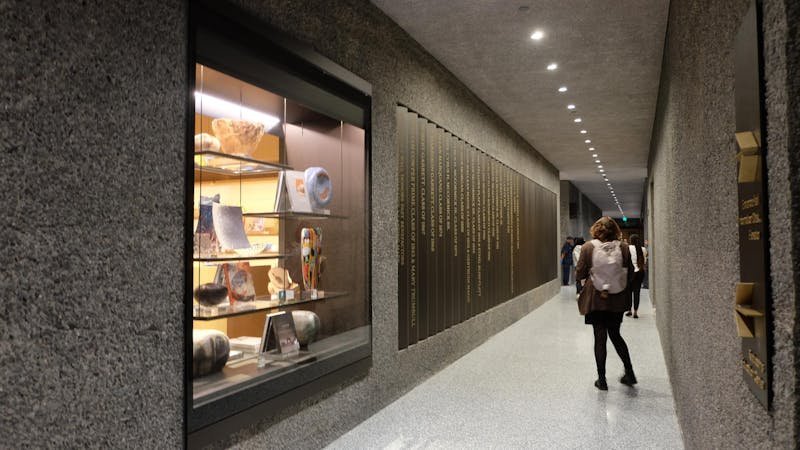Ahead of the formal opening of the Princeton University Art Museum (PUAM) next week, the Office of Advancement announced the dedication of 15 galleries and three pavilions on Oct. 7 following a years-long Venture Forward campaign.
The donations to PUAM include three “leadership gifts” from Nancy A. Nasher and David J. Haemisegger ’76, Preston Haskell III ’60, and the Fisher family, including Bill Fisher ’79.
“Princeton has a phenomenal art collection and it’s appropriate for a university like Princeton to have a museum like that,” Bill Fisher said in an interview with The Daily Princetonian.
The Grand Hall — a three-story open room that is able to be converted into a 250-person lecture hall — was supported by a gift from the Fisher family, including Bill Fisher, his parents Doris and Don Fisher, the founders of clothing line GAP. The family also includes his brothers Bob Fisher ’76 and John Fisher ’83, the principal owner of the Oakland Athletics, and his daughter and son-in-law Remy Fisher Wilkinson ’14 and Shane Wilkinson ’13.
“There’s sculpture and art all around you, and it just seemed like a beautiful place to hang out,” Bill Fisher said.
The rest of the first floor is primarily split into the Haskell Education Center and several locations named for the Nashers and Haemiseggers: the Nancy A. Nasher & David J. Haemisegger Family Hall and Grand Stair lead up to the second floor, and the temporary exhibition space currently hosting “Toshiko Takaezu: Dialogues in Clay” is named for their son, David Nasher Haemisegger ’22. The official title of Art Museum Director James Stewart is also named for Nasher and Haemisegger.
American Art is housed in the Wilmerding Pavilion, named by Louisa Stude Sarofim in honor of late Princeton professor of art and archaeology John Wilmerding, who was significant in the development of the Princeton American Studies department. The pavilion contains five galleries dedicated to the Anschutz family.
“I loved the old museum and am very excited to see how the art that I remember so well from my days as a student shines in the new spaces,” Sarah Anschutz ’93 wrote to the ‘Prince.’
She told the ‘Prince’ that Wilmerding “was one of my thesis advisors and I took many of his courses while I was at Princeton. We kept in touch over the years after I had graduated and [he] was helping my father transform his personal art collection into a small museum.”
Additionally, the Paul & Heather Haaga Conservation Studios in the south of the new building was named in honor of Paul G. Haaga Jr. ’70 & Heather Sturt Haaga. In the previous art museum, conservation space was limited to just one room; now, there are two floors spanning the south pavilion dedicated to conservation.
“[Conservation] was a function that, in the past, Princeton had to obtain from others,” Heather Haaga wrote in a statement to the ‘Prince.’ “Now art works can be preserved on campus without sending them out to another museum.”
In addition, the Haagas hope that students will be able to “learn the painstaking work of art repair and conservation.”

“It is a small world of incredibly talented people that keep art safe for future generations and now Princeton will be able to grow that world of experts,” Heather Haaga wrote.
Beyond monetary donations, art donations have been crucial to the opening of the new museum. The temporary exhibition, Princeton Collects, celebrates the more-than 2,000 works donated by more than 200 members of the Princeton community in the last four years, with around 150 works on show until March 2026.
Many other donors have also been honored through various rooms and galleries in the new museum, with two other pavilions named for major gifts from Yan Huo GS ’94 and Dori Walton ’78, Bill Walton ’74, and their children.
Paul Haaga wrote that he excited at the opportunity to “display a much greater percentage of the museum’s iconic collection.”
Having seen the gallery space in the Spring, Sarah Anschutz wrote she “was impressed by how beautiful the art looks in the new gallery spaces.”
“[It’s] a beautifully contained unit that has traffic flow through all different directions around the building, and is integral and fits into the University campus,” Bill Fisher said.
Nora Linssen is a News contributor for the ‘Prince.’ She is from Boston and can be reached at nl5023[at]princeton.edu.
Victoria Davies is a head News editor for the ‘Prince.’ She is from Plymouth, England and typically covers University operations and the Princeton University Art Museum.
Please send any corrections to corrections[at]dailyprincetonian.com.

